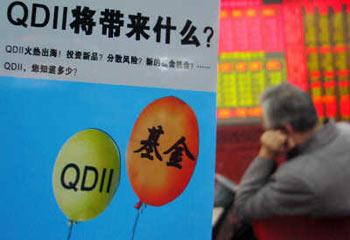Source: CCTV.com
06-10-2008 14:42
The QDII program launched with much fanfare two years ago. And when the first products became available in early 2007, private investors were quick to get in line.
 |
| The QDII program launched with much fanfare two years ago. And when the first products became available in early 2007, private investors were quick to get in line. |
Liu Xinglong, one QDII product buyer said "QDII products were very popular at that time. When I arrived at the bank at 9am in the morning, there were already many people there. I didn't get to buy my product until 11:30 a.m. that morning. It took me over 2 hours to wait. Frankly speaking, I didn't really know what a QDII product was. But it was so popular at the time, and the public seemed optimistic about its returns. So I also bought some."
So, what is the QDII program? And how does it work?
The Qualified Domestic Institutional Investor's program was introduced by the People's Bank of China in 2006. The program gives local institutions a chance to invest overseas through a range of foreign currency denominated products. Major players include banks and fund firms, through which individuals can entrust their money abroad. Insurers are also allowed to invest overseas, using their own capital.
Since September 2007, there have been more additions, with many more brokers and trust companies also clambering on board the QDII bandwagon.
The central bank's most immediate objective behind the QDII program is to reduce the amount of currency reserve in the central government's hands. Under the QDII program, part of the official foreign currency reserve is transferred into private hands. Individual investors can now access foreign currency –which the government use to hold. But experts say there is an even more basic, crucial objective behind the QDII scheme.
Li Daokui, Professor of School of Economics & Management of Tsinghua University said "QDII allows people like you and me to balance our investments. This is a way to generate welfare among the population, allowing the population to diversify their financial assets. Actually, to diversify their assets in general, not only financial assets. To me this is a more fundamental reason, than simply reducing the official foreign currency reserve."
But after the initial euphoria that greeted its launch, QDII products have quickly lost their luster. Their net values have been steadily falling, with key players seeing levels dip below the one yuan par value. Minsheng Bank really took a beating. The lender liquidated its QDII products in March when its net value dropped below half of the par value.
This was something no one had expected. And retail investors are feeling the pinch.
Zhang Zhaohui, one QDII product buyer said "The QDII product I bought is not performing well."
Liu Xinglong said "Just now I checked my QDII product. It's 0.79 yuan, compared with a one yuan par value. I've lost 20% of my investment so far, or around four to five thousand yuan."
Xu Xiaohong, one QDII product buyer said "I thought the overseas markets were more standardized, and that it would be easier to make money. That's why I bought QDII products in the first place. But the results have been disastrous. I've lost nearly 30% of my investment so far."
